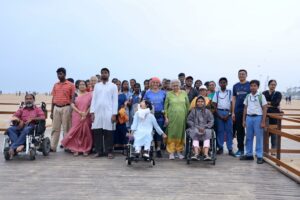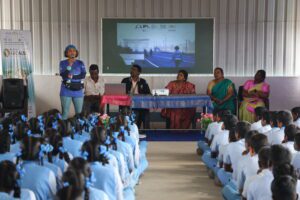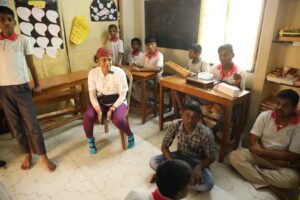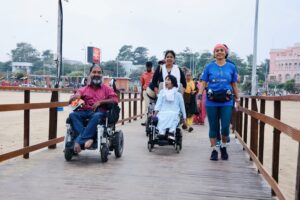
Gita Balakrishnan is currently on a 335 km journey on foot for the cause of Universal Design and Accessibility. (Supplied)
There wasn’t even a tad bit of tiredness in Gita Balakrishnan’s voice as she got on a phone call from a hotel in Kolar, one of her last few pit stops before her final destination – Bengaluru. The architect-researcher-educator is currently on a 335 km walk, all the way from Chennai for the cause of Universal Design and Accessibility.
“I’m feeling well. But I will be really fine in the next couple of days as my destination is now just 40 kilometers away,” she tells South First.
The campaign, Mphasis AVAS Walk for Arcause 4.0, is to raise awareness about creating inclusive environments for all regardless of abilities and disabilities with no barriers of age, ability, and background. As the infrastructure around us is rarely conducive to people with disabilities, coming together to build a society that enables them to live an independent life is at the core of this initiative.
Balakrishnan started the walk from Chennai on 7 January, 2024.

Gita started her walk from Chennai on 7 January, 2024. (Supplied)
She has a team with her including a logistics manager, a photographer and people to help with the tech support for her presentations enroute. But the walk, she is doing alone.
“The idea is to get people to notice you. We want them to come and talk to us. This time around, we have introduced fellowships where I’m taking a young student or an architect with me so they also get the experience,” says Balakrishnan, who is the founder of Ethos Foundation.
This isn’t a first for Balakrishnan, who has done three walks previously.
“My first ever walk was in February 2022. It was 1,700 km, from Kolkata to Delhi via Madhya Pradesh,” she recalls. While on the walk, she identified over six areas that she wanted to focus her work on. And universal design was one of them.
The people she met on her first walk inspired her to work more in the field.
“On day 16 of my walk, in Ranchi, I went to a school for children with disabilities. There I met a young lady on a wheelchair who had lost her limbs. She was also the winner of the Miss India Wheelchair title. That got me thinking as to why she was Miss India Wheelchair and not just Miss India. Just because she was in a wheelchair, what’s the need for a separate category?” she asks.
On day 51 of the walk she had an interaction with a visually challenged person, which made it all the more clear for her.
“I went to his home. There was a guy who met me at the door, ran up the steps, switched on the lights, opened the door, and got the harmonium out and offered to sing for me. As I was tired from a 28 km walk that day, I asked him if I could quickly meet with Harshvardhan Dube. To my surprise, he revealed that he, in fact, was Harshvardhan Dube, the visually challenged person I was there to meet,” Balakrishnan recalls.
It shook her up that he was moving around so conveniently.
“He told me that in his house he could do just about anything but the minute he steps out, it is impossible for him to move around,” she adds.
After the two interactions, it became imperative to Balakrishnan that architects, designers and urban planners need to look at inclusive design as a very important matter. And that’s how the project UDita- Universal Design Is The Answer came about. She submitted the proposal to Mphasis for their CSR project and that was just the beginning.
It’s not just the walk but there are multiple projects that the team is doing alongside.

As part of this walk, Gita conducts talks and presentations at various institutions. (Supplied)
“We’re creating learning content. Architects may want to comply with universal design but they need information on what should be done differently, what materials to use, what persons with visual impairment need, and what people on wheelchairs need. We are not taught much of it in school. So we want to curate all the content in one place,” shares Balakrishnan about her vision.
There are also faculty development programs, grants to execute small projects – such as a building a ramp, putting up tactile tiles or using low-vision colours in spaces for those who need it.
“We are doing all this to instill empathy in people as well as designers. So when common people build a school or their own homes, they feel it’s important to make it accessible. I have met so many people who never imagined they would lose their vision or their limbs and when it did, they didn’t know how to cope. So we are telling people that it can happen to any of us and we need to prepare,” she says.
The walk so far has been a revelation, Balakrishnan tells South First.
“The first couple of walks were more about discoveries. I didn’t know what I was going to encounter. But here, we know that universal design is at the core of this walk. Everyday there are curated interactions at different places from schools, colleges, NGOs to railway stations and fire stations. We know what we are looking for and what questions to ask, how to probe and get responses,” she shares.

At the Anbalaya Foundation. (Supplied)
For more research, the team has visited the Anbalaya Foundation, National Institute for the Empowerment of Persons with Visual Disabilities (NIEPVD), Schieffelin Institute of Health Research and Leprosy Center, Antharaganga Vidya Samsthe and Vishranthi Old Age Home.
“The sad part is that most of the time, people with disabilities have to change themselves to be accepted and be able to live a reasonably normal life. We wanted to learn how visually impaired people navigate and the challenges people with leprosy deal with. So we would ask doctors and learn about what kind of designs will help them,” she notes.
While on her first walk, Balakrishnan did 25-40 km at a stretch, this walk is at a much friendlier space.
“21 km has been the highest that I have done. There are around two hours of interaction that we are doing everyday. We also come across people as we go, like people on morning walks and children on school trips. I tell them what we are doing and when they show interest, we talk more.”
And how does she prepare for something so strenuous? The best way to prepare for a walk is to walk regularly, Balakrishnan says.
“I’m a runner. I don’t have a great pace but I have done four full marathons and many half ones. I started running when I was 45. Now it’s been 10 years,” she says adding that for this walk, she started training in November.
She started with a one-hour walk, then made it 1.5, 2, 3 and so on, no matter where she was.
“In between, I had to travel to the US and I walked everyday no matter how cold it got. I even walked for three hours during a layover at Singapore airport,” she says, adding that on alternate days, she works on strengthening her lower body with squats, lunges and other exercises.
Being mentally fit is also important, she stresses.
“You are used to certain luxuries when you are home. You have to throw them out and accept what you have here, sleep on different beds, eat what you get. So mentally, you should be ready,” she says, adding that she takes protein supplements while on the walks, and carries dry fruits and hydration fluids on her.

The spirit of the walk keeps her going, Gita says. (Supplied)
While small discomforts like acidity are bound to occur, Balakrishnan says that due to the spirit of these walks, she’s managed without falling sick.
The real challenge on the other hand, she says, is to get government officials to speak.
“We are not asking them to reveal anything about their work. In fact, some of them are doing good work, but they are not willing to share anything on camera without prior permission. We have managed to get people at NGOs, and students to speak and it’s been amazing. If I have to write to people, wait a week for permission to talk, it becomes very difficult to interact with them at all. I think it’s important that they have permission to share freely,” she points out.
Her family, Balakrishnan says, is as excited for these initiatives as she is.
“Not once have they expressed any reservation. They are always looking forward to hearing my updates. My husband is also a runner. Because of his corporate job he’s not been able to come with me for my walks. But after this year, he’s retiring and for my next walk, I will have a walking companion,” she shares.
For her future walks, Balakrishnan has a few places in mind.
“There are a few sectors that I have in mind but I’m not walking for the sake of walking. I want to tie it up with something meaningful. I want to go to Maharashtra. I’m keen on doing Kochi-Calicut someday. Punjab would be nice too,” she adds.
In the run up to her arrival in Bengaluru, her team is conducting workshops for architecture students, and doing sign language classes at Mitti Cafe, among other activities. On 28 January, there will be a commemorative walk from Cubbon Park to the Museum of Art and Photography followed by a gathering there. And at the closure, she will share her experiences through PPT and interact with the participants.

Jul 26, 2024

Jul 21, 2024

Jul 20, 2024

Jul 20, 2024

Jul 19, 2024

Jul 18, 2024